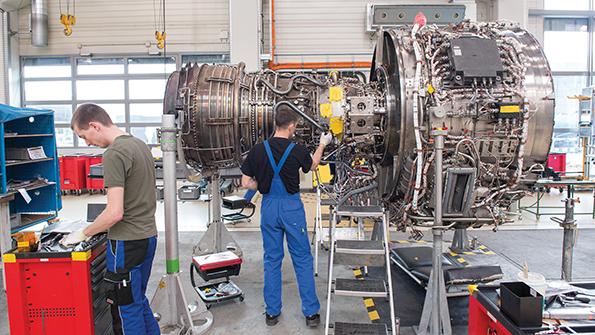
The V2500 engine remains a narrowbody workhorse amid strong traffic demand and delivery delays.
Aftermarket providers are not immune to the supply chain constraints weighing down ambitious ramp-up plans at Airbus and Boeing. But when original equipment manufacturers delay deliveries amid high demand, aftermarket providers must scramble to manage the ramifications.
That trend, combined with strong demand for lift practically everywhere, has the maintenance, repair and overhaul (MRO) business booming. RBC Capital Markets projects full-year 2023 civil aftermarket business will grow at about 20%, and that is on the heels of a solid 2022 bolstered by high demand in many regions.
- MRO demand is expected to rise 20% this year
- Supply chain bottlenecks are prompting changes
- In-sourcing is in
Guidance from a few major players supports this outlook.
Raytheon’s Pratt & Whitney division sees its aftermarket business growing 20-25%, while Safran is eyeing revenue growth in the low-20% range, driven primarily by its CFM International joint venture.
The COVID-19-pandemic-induced downturn was supposed to drive a wave of aircraft retirements and increase the percentage of new deliveries replacing older airframes, versus adding capacity. While this will play out over the next several years, it has yet to happen due to the combination of OEM delivery struggles and the rapid traffic rebound.
The trend means airlines must keep older airframes and engines around—or in some cases acquire them to fill gaps—to keep up with demand. That in turn is boosting MRO business and forcing some aftermarket service providers to change their plans as well.
The International Aero Engines V2500 has been a narrowbody fleet workhorse for years, but its prevalence was expected to plateau if not wane by now. Instead, the strong post-pandemic narrowbody rebound combined with OEM delivery delays means extended life for the venerable engine model.
“We see [V2500] shop visits going up” in 2023, says Raytheon CEO Gregory Hayes. “Call it from around 700 to the mid-800s. So [there is] a lot of tailwind there. . . . Three years ago, we thought the [V2500] was kind of going to be petering out, [but] retirements have been almost nonexistent in that fleet. There are still about 6,000 engines out there, which is double the number of [Pratt & Whitney PW1000G geared turbofan] engines in service today. That aftermarket continues to be very strong.”
Larger-than-expected demand from legacy platforms is good news for engine OEMs and major MRO shops, but it comes with its own challenges. Some of the oldest current-generation engines, notably the PW1000G and CFM Leap families, are entering their initial shop-visit windows. But many overhaul facilities have been buzzing with work on these engines for several years due to lower-than-expected on-wing times before major work was needed.
The new-engine reliability issues drive a need for work on older engines to fill the gaps, creating an engine maintenance crunch.
“The biggest issue is not [about reliability] but the turnaround time on the engines themselves,” Frontier Airlines President and CEO Barry Biffle says.
Some providers are responding by taking a larger role in their own supply chains. MTU Maintenance Serbia is one of German engine specialist MTU Aero Engine’s newest facilities. Opened late last year, its focus is parts repair—and it is ramping up fast. The shop is adding capability at the rate of about one new part repair per day, Les Cronin, MTU vice president for marketing and sales in the U.S., noted at the recent Aviation Week AeroEngines Americas conference.
Serbia is helping the company bring some outsourced work in-house and lessen its reliance on vendors struggling to keep up with demand.
While such examples suggest progress, the gap between supply and demand—whether new-engine deliveries, spare parts or repairs—is not going away anytime soon.
“Supply is growing at a very rapid rate, but demand is outpacing it,” GE Aerospace Materials General Manager Horacio Repetto says. “We’re going to have to work closely together in the next year or two, plus be well-coordinated on how we meet that demand.”
Engine OEMs are boosting maintenance capacity across the board. GE Aerospace added 1,300 people across its network of overhaul shops last year and is gearing up for a 20% increase in engine shop visits this year, Repetto says. But the engine-makers cannot control demand. “It’s not about when the supply chain gets healthy,” he says. “It’s about when it catches up to demand.”
Like MTU Serbia, American Airlines took a different approach to one of its demand challenges by boosting internal capability. The carrier used the pandemic’s low activity period to improve its Tulsa, Oklahoma, engine overhaul facility. One result: a near halving of average overhaul turnaround times for workhorse CFM56-5B and -7B engines to about 50 days.
A more efficient shop means more capacity. After completing 30 heavy overhauls in 2019, the shop performed more than 100 in 2022, says Mark Miner, American Airlines vice president of technical services. This year’s figure will be closer to 120.
Smaller companies are taking similar steps. Used serviceable materials specialist Setna iO got a jump on the current used-parts demand trend by purchasing airframes and engines more than a year ago, says Hunter Edens, head of commercial.
Setna iO soon found that its capacity for the work necessary to get usable components into buyers’ hands, such as engine teardowns and parts repairs, was strained. So it invested in its own auxiliary power unit repair facility to help bring the in-demand components to market faster.
Its next step: developing its own engine disassembly capability to make sure that parts reach end users—and money flows into its coffers—even more quickly. “The objective that we’re pursuing is trying to control as much of the front-end supply chain as possible,” Edens says.



